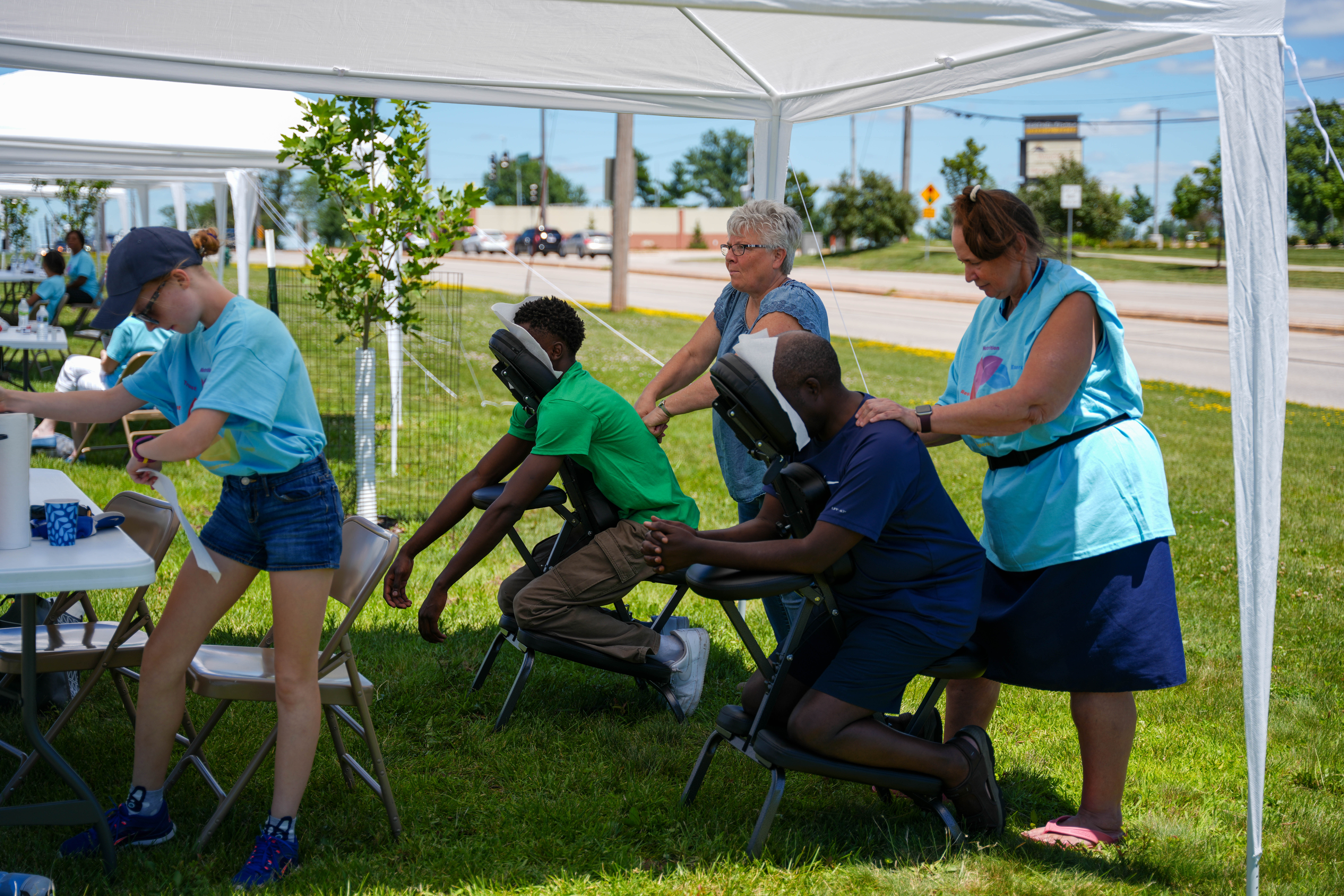I found myself standing on a makeshift wooden platform in the middle of a sandlot in Nigeria. People were scurrying back and forth to finish preparing the stage for the nightly meetings that would begin the next day. As I was contemplating what the next few weeks would bring, a man interrupted my thoughts.
“We want to be like you,” he said. His comment startled me.
“We hear the churches in America are vibrant and growing fast. We want to be like you.” I hardly knew what to say. It pained me to tell him that although there are churches in America that are vibrant and growing, there are many that are in desperate need of revival and reformation.
Questions flooded my mind. Why is it that we hear these exhilarating stories from other parts of the world of mass baptisms and thousands attending evangelistic meetings? Why is it that we hear of packed churches and overflowing Sabbath Schools in other countries? Why is it that we hear of overseas conferences planting hundreds of new churches and companies each year? Why is this happening in other parts of the world but not as much in North America? It made me wonder, “What must we do to promote revival and reformation in North America?”
Eye opening discovery
I know that the answer is prayer, but prayer must be combined with action. What can we actively do? I pondered this question for some time. Then I found part of the answer in the most unlikely place. I was sitting in the rugged dining room of one of our overseas conference offices preparing for an evangelistic meeting. My eyes were drawn to the wall on the right side of the room. What I saw opened my eyes.
On the wall was a list of the churches and companies and the pastors who were in charge of each district. I was amazed to see that many pastors had 10 or more churches in their district. Each church was led by lay people and elders who might see their pastor only once a quarter–and many of these churches were growing. I began to question, “How can this be? They see a pastor once a quarter and yet they are growing? These churches are essentially led by local church members and they are doing just fine. If my churches back in America only saw me once a quarter there would be a rebellion!”
Then I discovered something remarkable. Nearly every country in the world where the church is growing rapidly has been organizing lay led churches for years. Finally it hit me. The New Testament church formed lay led churches from the start and experienced the same rapid growth. They were led by ordinary people encouraged by the apostles and empowered by the Holy Spirit. This is how the church was able to evangelize the world.
This revelation was quite a shock to me. I wondered,
If this is what the New Testament church did, is that what we should be doing in North America?
Is that what I should be doing with the churches I am pastoring?
These questions plagued my mind. I wanted nothing more than to see the Adventist church in North America experience revival and reformation and growth again.
Original model for church structure
As I searched the Bible, I discovered something that caught my attention. There were no paid pastors overseeing a congregation or house church and doing ministry for the people in the early New Testament church. Those who were paid by the tithe (and there wasn’t much tithe in the first centuries) were sent out to evangelize and plant churches in unentered lands and cities. Tithe was reserved specifically for this purpose. The existing churches were left in the hands of capable lay people. This is why the apostles raised up elders and deacons in each church. We read in Acts and Titus for example:
“So when they had appointed elders in every church, and prayed with fasting, they commended them to the Lord in whom they had believed.” (Acts 14:23 NKJV)
“For this reason I left you in Crete that you should set in order the things that are lacking, and appoint elders in every city as I commanded you….” (Titus 1:5 NKJV)
There are numerous references in the New Testament to elders and other members being the leaders of the churches. This is why most of the books of the New Testament are letters to churches. As the apostles evangelized new cities and towns they wrote letters of instruction and encouragement back to the leaders of the churches. The elders and deacons were to lead the churches, and ministry was put into the hands of the church members (i.e. laity). It would have been unheard of for tithe to be used to pay someone to oversee a church when there were elders and deacons to do that. It would have been seen as a waste of money.
The tithe was used to support “workers” laboring to evangelize new areas.
Following this method, the early New Testament church grew astronomically. When the work of ministry was put into the hands of lay leaders the spiritual life of the church exploded. It was under this structure of completely lay led churches that Christianity took the Gospel to the world of the first centuries. This cannot be denied.
Early Adventist church: Same song, second verse
Then I discovered something even more remarkable. This was also the structure under which the early Adventist church began. In the humble beginnings of the Advent movement there were no paid pastors assigned to churches. Most churches and house groups were completely led by lay people. Ministers who were paid from the tithe functioned as evangelists and church planters in unentered areas, just like the New Testament church. When new churches were planted the lay people were trained to lead the church and the minister moved on to another unentered area. This is a major reason why the early Adventist church grew so rapidly.
In the early 1900s, people began noticing the growth of the Adventist church. Other churches had been around for hundreds of years, but here was this new denomination that was not even 50 years old yet growing so rapidly. The Adventist church carried forward the Gospel Commission very differently than other Protestant churches. Most other churches followed the method of appointing a paid pastor over each church. The Adventist church did the opposite.
Churches were led by lay people while tithe was used to send workers to evangelize and work in unentered fields.
When asked about this, A.G. Daniells, president of the General Conference in the early 1900s, said, “We have not settled our ministers over churches as pastors to any large extent. In some of the very large churches we have elected pastors, but as a rule we have held ourselves ready for field service, evangelistic work and brethren and sisters have held themselves ready to maintain their church services and carry forward their church work without settled pastors. And I hope this will never cease to be the order of affairs in this denomination for when we cease our forward movement work and begin to settle over our churches, to stay by them, and do their thinking and their praying and their work that is to be done, then our churches will begin to weaken, and to lose their life and spirit, and become paralyzed and fossilized and work will be on a retreat.” (A.G. Daniells, Ministerial Institute Address, Los Angeles, California, March 1912, as quoted in Russell Burrill’s book Recovering an Adventist Approach to the Life and Mission of the Local Church, p. 177-178).
I was struck with more conviction when I found that Ellen White echoed the same counsel. “There should not be a call to have settled pastors over our churches, but let the life-giving power of the truth impress its individual members to act, carrying on efficient missionary work in that locality. As the hand of God, the church is to be educated and trained to do effective work. Its members are to be the Lord’s devoted, Christian workers.” (Important Testimony 5)
A.G. Daniells may not have known it, but his statement in 1912 was prophetic. He said if we ever stopped organizing lay led churches and began to settle pastors over churches instead of sending them into unentered fields that the growth of the Adventist church would decline and its spirituality would suffer. It appears this is exactly what happened in the first half of the 1900s.
Not long after Daniells’ presidency and the death of Ellen White, people in the church began to call for settled pastors. They saw that the other popular Protestant churches had big buildings and large congregations and they wanted to copy the methods of these other churches. Like Israel of old, God’s people insisted on having a “king” rule over them, even though this was not God’s plan.
When you look at North American membership records during the first half of the 1900s you will discover that the very time period when we stopped organizing lay led churches was the time when church growth started to decline and become stagnant in North America.
We lost our focus on mission. I couldn’t help but wonder, “Is it time for Adventism to return to lay led churches in North America?”
If we don’t, how will we ever finish the work? Revelation 14 has given us an important commission—a God-sized task. We have been told to take the everlasting Gospel to every nation, tribe, tongue, and people. Ellen White has also instructed us to take the light to all people groups and to erect a humble house of worship in those places. (See Testimonies vol 6, p. 100) How can we possibly accomplish this monumental task of taking the Gospel to every town in North America and erecting a humble house of worship? It would cost a fortune! If every church must have a paid pastor, we could never afford it!
Lay led churches are growing churches
I could only come to one conclusion: We must start organizing lay led churches again. We must let elders and deacons lead churches while tithe is used to send workers to evangelize and plant churches and house groups in towns and cities in North America that have no Adventist presence.
For the sake of the mission, we have to do it!
For the sake of the Gospel Commission, we have to do it!
For the sake of the lost whom Jesus loves, we have to do it. It may not be comfortable. But we have to do it. It is our duty and responsibility as the remnant who have been entrusted with taking the final message of Jesus to a lost world.
Time for change
What would happen if churches in North America would do this? What would happen if we started gradually transitioning churches to be lay led by trained, dedicated elders and deacons? Then the ministers could be sent to nearby towns and cities to evangelize and plant churches where no Adventist presence exists. Like the apostles of the early church, the minister would return to the churches periodically to provide further training and encouragement, but the majority of his time would be spent in raising new churches and companies. Imagine how this would change the face of the North American church!
I believe returning to the Biblical model of lay led, spirit-filled churches would greatly contribute to the finishing of the work and help to usher in the revival and reformation we have been longing for.
God has special plans for the Adventist movement in these last days. It’s an exciting time to be an Adventist. I’m willing to move in the direction of having lay led Adventist churches to finish the work. How about you?
David Klinedinst is the resident conference evangelist for the St. Louis metro area.










